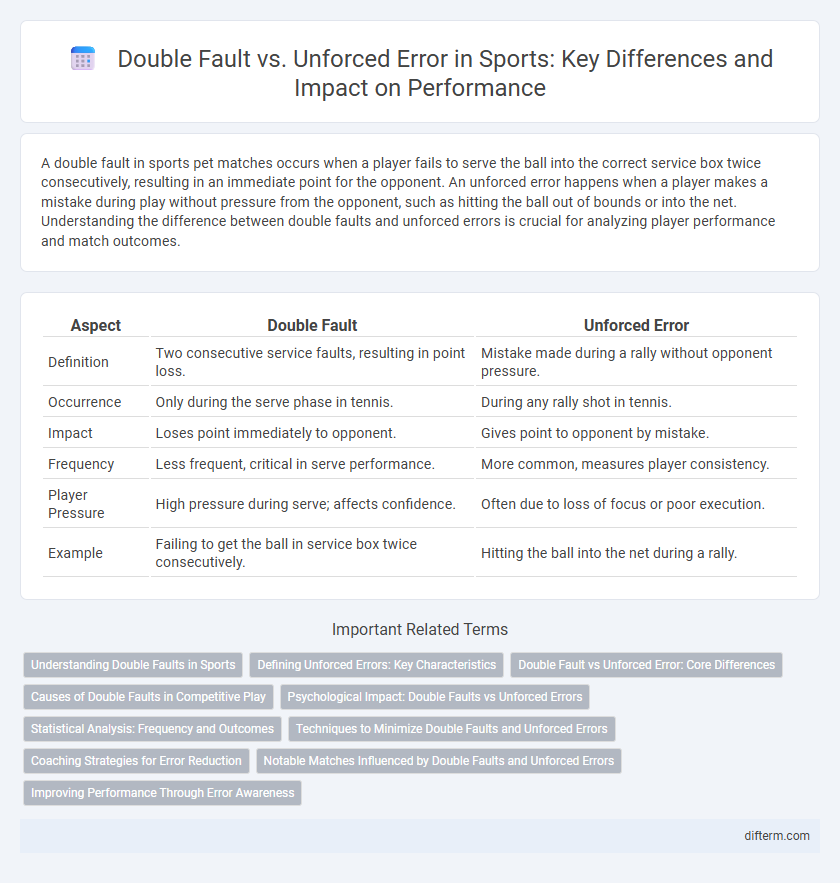A double fault in sports pet matches occurs when a player fails to serve the ball into the correct service box twice consecutively, resulting in an immediate point for the opponent. An unforced error happens when a player makes a mistake during play without pressure from the opponent, such as hitting the ball out of bounds or into the net. Understanding the difference between double faults and unforced errors is crucial for analyzing player performance and match outcomes.
Table of Comparison
| Aspect | Double Fault | Unforced Error |
|---|---|---|
| Definition | Two consecutive service faults, resulting in point loss. | Mistake made during a rally without opponent pressure. |
| Occurrence | Only during the serve phase in tennis. | During any rally shot in tennis. |
| Impact | Loses point immediately to opponent. | Gives point to opponent by mistake. |
| Frequency | Less frequent, critical in serve performance. | More common, measures player consistency. |
| Player Pressure | High pressure during serve; affects confidence. | Often due to loss of focus or poor execution. |
| Example | Failing to get the ball in service box twice consecutively. | Hitting the ball into the net during a rally. |
Understanding Double Faults in Sports
Double faults occur in tennis when a player fails to deliver a valid serve twice consecutively, resulting in the loss of a point. This differs from an unforced error, which happens during regular play when a player mishits or misses a shot without pressure from the opponent. Understanding the impact of double faults helps players and coaches emphasize serve consistency and mental focus to minimize costly point losses.
Defining Unforced Errors: Key Characteristics
Unforced errors in sports, particularly tennis, occur when a player makes a mistake without pressure from the opponent, such as missing an easy shot or mishitting the ball. These errors are characterized by a lack of external factors causing the mistake, highlighting lapses in concentration or technical execution. Understanding unforced errors is critical for analyzing player performance and improving consistency during matches.
Double Fault vs Unforced Error: Core Differences
Double faults occur when a player fails to successfully serve the ball twice consecutively, immediately resulting in the loss of a point, emphasizing serve accuracy and pressure handling. Unforced errors, by contrast, are mistakes made during regular play without opponent pressure, often reflecting lapses in concentration or technique. The core difference lies in the nature of the error--double faults impact the serve directly while unforced errors pertain to general rally mistakes beyond the serve.
Causes of Double Faults in Competitive Play
Double faults in competitive tennis often stem from factors such as pressure-induced tension, inconsistent toss, and poor technique during the serve motion. Mental lapses and over-aggression on second serves increase the likelihood of missing the service box entirely. Fatigue and lack of proper focus further exacerbate these errors, distinguishing double faults from unforced errors, which typically arise during rallies rather than service attempts.
Psychological Impact: Double Faults vs Unforced Errors
Double faults often trigger a stronger psychological impact on players due to the pressure of failing on their serve, which can disrupt focus and confidence immediately. Unforced errors, while damaging, are perceived as less self-inflicted pressure since they occur during rally exchanges, allowing players to mentally reset more easily. Managing the mental aftermath of double faults requires resilience to prevent a cascade of mistakes, making psychological recovery crucial in high-stakes matches.
Statistical Analysis: Frequency and Outcomes
Double faults occur less frequently than unforced errors in professional tennis matches, typically constituting about 1-3% of total points played, while unforced errors can account for 20-40%. Statistical analysis shows double faults often result in immediate loss of service points, critically impacting player momentum, whereas unforced errors, though more common, have a varied impact depending on match context and point importance. Data-driven assessments reveal that minimizing double faults correlates strongly with higher first serve percentages and improved match-winning probabilities.
Techniques to Minimize Double Faults and Unforced Errors
Minimizing double faults requires a consistent serve technique, emphasizing proper grip, stance, and follow-through to maintain accuracy under pressure. Reducing unforced errors involves improving footwork and shot selection, alongside mental focus during rallies to maintain control and reduce unnecessary risks. Training drills that simulate match conditions enhance muscle memory and decision-making, effectively lowering both double faults and unforced errors.
Coaching Strategies for Error Reduction
Coaching strategies for reducing double faults emphasize consistent serve technique refinement, targeting optimal toss height and improved racket speed to enhance accuracy. In contrast, unforced error reduction focuses on developing mental resilience, shot selection discipline, and controlled aggression through repetitive drills and situational play simulations. Effective coaches tailor training programs to address these distinct error types, utilizing video analysis and biomechanical feedback to optimize player performance and minimize match turnovers.
Notable Matches Influenced by Double Faults and Unforced Errors
Double faults and unforced errors have critically impacted outcomes in notable tennis matches such as the 2009 Wimbledon final, where Roger Federer's unforced errors allowed Andy Roddick to challenge fiercely. The 2014 US Open match between Marin Cilic and Kei Nishikori featured multiple double faults that shifted momentum and ultimately decided the victor. Analyzing these pivotal moments highlights how precision and mental resilience under pressure influence match results significantly.
Improving Performance Through Error Awareness
Double faults in tennis directly cost points and highlight serve consistency issues, while unforced errors reveal lapses in shot selection and focus during rallies. Understanding these error types enables players to target specific weaknesses, refine technique, and develop mental resilience. By analyzing match statistics on double faults and unforced errors, athletes can implement focused training strategies that enhance overall performance and competitive outcomes.
Double Fault vs Unforced Error Infographic

 difterm.com
difterm.com